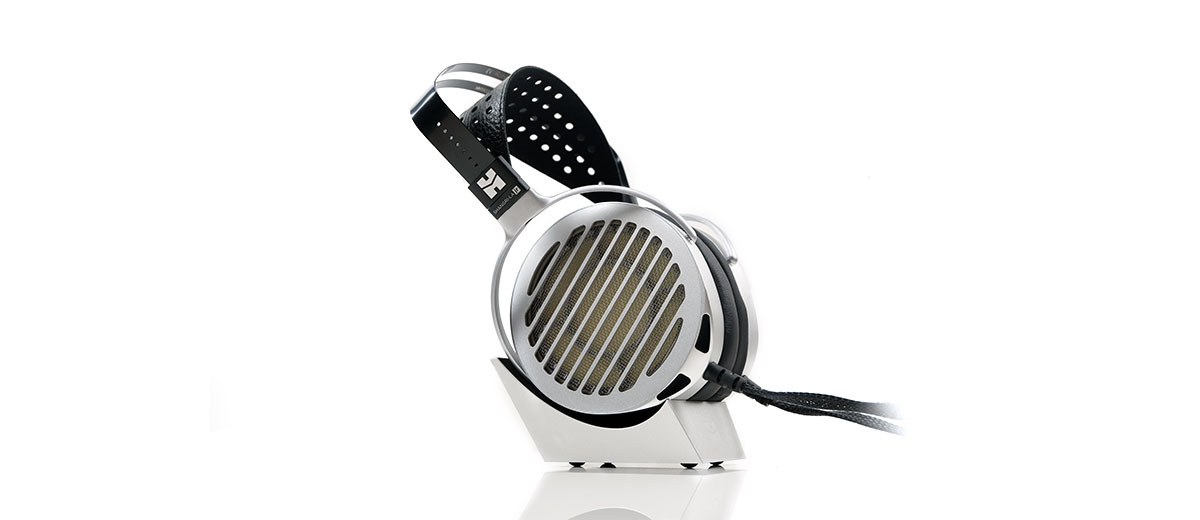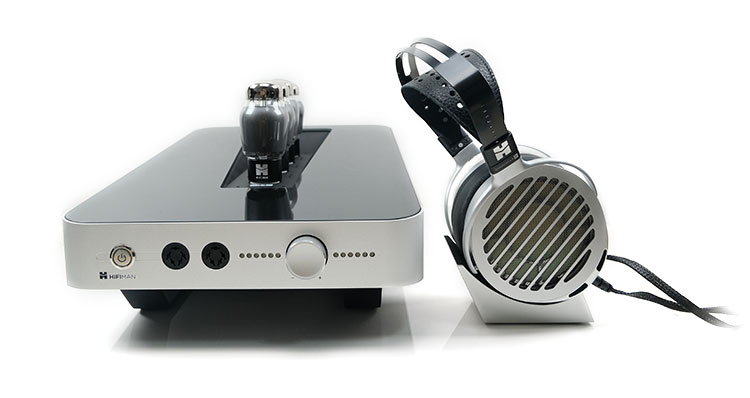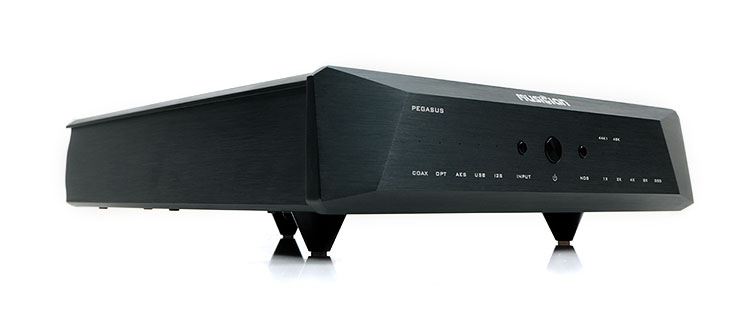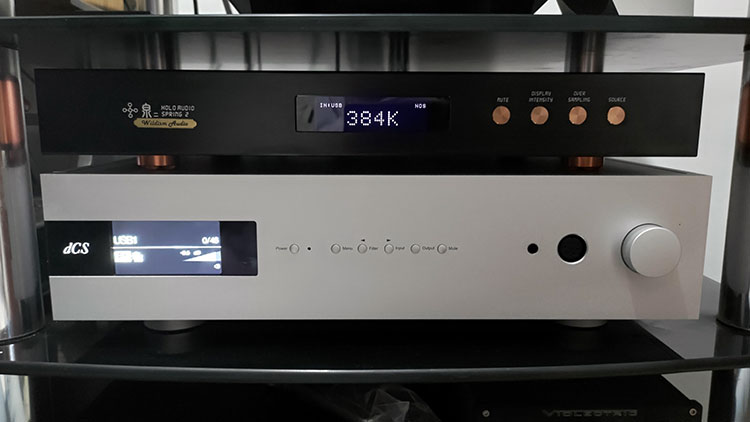Sound Impressions
Summary
The Shangri-La Jr headphones deliver a relatively neutral and clean sound signature that is acoustically very transparent with bags of headroom and fantastic clarity.
What I mean by transparent is that is indeed source-dependent so your source and amplifier will have a final bearing on just how smooth or dynamic the sound from the headphones can be.
If you are coming from the Jade II the Shangri-La Jr sound is quite different, offering a more physical experience with attributes and resolution levels more in line with the Voce and SR-007 MK2 upwards.
You can read more about the pros and cons of these three in more detail in our comparison section further down.
Frequency Response
The overriding impression of the Shangri-La Jr headphones is a beautiful blend of neutral to slightly warm on the low-end and a cleaner to slightly brighter overtone up into the mids and highs.
The low-end is quite linear but certainly extends a lot better than the Jade II generating a superior sub-bass response and improved depth. It extends just as well as the likes of the VOCE and you will hear roughly the same presence levels sub-100Hz. However, the ‘snap’ and transient response is just a little tighter and faster sounding.
For those coming from the 007 MK2, it is not as warm or as physical with less of a mid-bass bump. In fact, the Shangri-La Jr is quite flat from 100Hz up to around 500Hz so it does not convey the same amount of weight nor does it sound as dominating on the low-end as the 007 MK2.
There is also a slow rise and bump in the 500Hz to 1k area allowing for a bit more lower-mids presence and combined with the better low-end extension you will hear a denser more physical sound for lower-pitched instruments than the Jade II.
Upper Mids are neutral to slightly north of neutral with a very precise vocal image but a mild 2-4k peak means it is not as forward sounding as the Jade II’s vocal imaging but definitely offering more body.
The treble does have some excellent extension and energy and you will hear it in the Jr’s harmonic balance but it is still relatively secondary to the upper-mids peak. Thus, I never found it to be overly harsh or peaky, particularly with a good source such as an R2R DAC and a tube-based energizer.
Timbre
With the right setup, this is a gorgeous-sounding timbre treading a delicate balance between that traditional electrostatic penchant for outstanding clarity and a dash of warmth for listenability. I do not find any aspect of the tonal coloration to be overly fatiguing, thin, or overly rounded.
Granted, those coming from planar headphones such as the Susvara will find a little more impact and physicality. Stats headphones have always presented a perception of weight and size rather than ram it down your throat.
However, personally, I do not find the Shangri-La Jr headphones wanting in terms of above-average fundamentals in their low-end instrumental coloration. You do get a slither of warmth in an otherwise neutral bass curve that keeps lower pitching instruments to the natural rather than the dry side.
Beyond that, the mids have a bit more contrast with a peak around 4k picking up a bit more treble coloration so instrumental and vocal performances will have a cleaner edge to their timbre.
The treble tuning in its own right is not hugely forward and is tuned more for headroom with plenty of post-10k elevation. Rather the 4-5k point is probably the highest point in the FR so it quickly picks up odd harmonic overtones.
Transparency
Your source and chosen amp will play an important role here because the Jr is fairly transparent in its performance and can be unforgiving with poor synergy. Anything dry or bright will accentuate that leaving the Shangri-La Jr headphones sounding equally so, particularly for percussion and female vocals.
For example, the Shangri-La Jr hybrid tube amp combined with the Holo Audio Spring DAC 2 sounds immaculate with a very black background and natural but clear instrumental timbre. Vocals have a very slight dissonance depending on the source mix but otherwise, the texture is excellent.
However, switch over to the less powered and more clinical sounding Stax SRM-D10 and you get a harsher sounding vocal timbre and far less low-end warmth to counter it.
Staging
There is the absolute and then there is the comparative. In an absolute sense, I have heard wider and deeper soundstages but normally from the likes of the HD800 and the Susvara which are not electrostatic headphones.
For a comparative gauge, the Shangri-La Jr extends as deep as competitors such as the VOCE but offers more headroom and an airier midrange. You also get a stronger perception of space or separation and certainly better width than the Stax SR-007 MK2 if not quite the same low-end power.
Running throughout the FR of the Shangri-La Jr, however, is a superb transient response and outstanding articulation. Delicate and complex sound passages have no problems in terms of resolution and instrumental separation.
Imaging is very accurate indeed though Jade II users will find the 1-4k mids peak a bit more relaxed than what they are used to so it is not quite as vivid or as forward for vocal presence.
What you get instead though is a bit more solidity and superior dynamic range, especially on the low-end and lower mids. It does away with that ethereal soundstage of the Jade II and produces something a bit more realistic and natural.
Synergy
Efficiency
The good news is that the Stax SRM-D10 will not have any issues driving the Shangri-La Jr. That will give you a degree of portability with enough current to get fairly loud at about ‘noon’ to ‘2pm’ on the volume pot.
However, the bad news is that it felt a bit thin and bright and lacking in bass dynamics which I suspect is more down to the ES9018 DAC chipset inside than the amplification stage itself.
And true enough, bypassing the DAC with a dedicated 3.5mm line-in from the HiBy R8 brought a fuller and more natural sound from the Shangri-La Jr. With the DX300‘s AMP11 card LO output to the D10, you get an even stronger analog overtone, wider staging presentation, and better midrange vocal presence.
However, once you move up to more capable desktop amplifiers the Shangri-La Jr delivers a far better level of dynamic range and a beefier bass response. Both the 340Vrms max output tube-based Stax SRM-007tII and Hifiman’s own Shangri-La Jr hybrid tube amplifier produce a deeper and more holographic soundstage compared to the 200Vrms D10.
That theme continued with the VE Enterprise E Lite, a 325Vrms RMS capable tube amp and somewhat similar to the old Stax SRM-T1 but with a BFT input stage, not JFET. You will have zero issues driving it from this amplifier, barely hitting ‘9am’ on the dial when receiving a balanced input signal from a 4.1v LO source.
Source Pairings
All three of my tested desktop amps are tube amps, the SRM-007tII, the Shangri-La Jr hybrid tube amplifier, and the Enterprise E Lite. All three amps produced a richer, weightier, and more expansive performance than the SRM-D10.
However, aside from the slightly weaker output of the D10 diminishing the dynamic range, the secret sauce for pairing for the Jr headphones was heavily influenced by the choice of DAC and not just the amplifier alone.
Granted, there are some nuanced differences in the amplifiers such as the 007tII sounding a little sweeter and not quite as bombastic on the low-end as the other two amplifiers. However, the choice of DAC did a lot more for the overall synergy of the pairings between each amplifier.
I actually started the review process with a Chord Qutest attached to the Shangri-La Jr system, (headphones and amplifier), and found the overall tone to be punchy and dynamic but also somewhat drier than I would like. The Qutest also teased out a bit more treble shine and for the Jr headphones to sound at their best you do want to keep the treble under control.
R2R Sources
Enter R2R DACs, namely the Musician Audio Pegasus and the very impressive Holo Audio Spring 2 DAC, (Wildism Edition). Both of these DACs delivered a far more natural tone to the Shangri-La system as well as the Stax SRM-007tII when paired with the Shangri-La Jr headphones.
In terms of sheer resolution and dynamic range, Spring 2 was the more resolving of the two R2r DACs with the Pegasus just marginally shrinking the staging potential of the pairings when compared side by side.
However, the Pegasus does deliver a beautifully weighted texture which both amps and the Jr headphones gobbled up. Importantly, the treble was on the right side of energetic with less of a dry edge compared to the Qutest.
The Spring 2 DAC is also probably the most life-like of the R2R source pairings and with both the Stax and the Jr amp it sounded bold, rich, and much smoother than either the SRM-D10 Sabre DAC or the Qutest.
Click on page 3 below for select comparisons








